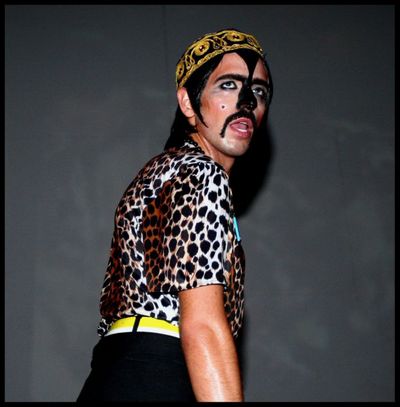Boy Genius: Ssion’s Art of the Music Video

After openings at The University of Chicago, Kansas City’s Grand Arts, and Los Angeles’s Peres Projects earlier this year, Ssion’s feature film BOY (2010) finally descended upon New York on Monday night, screened in the perfectly bizarre setting of Gramercy Park’s National Arts Club. The choice to show BOY in NAC’s staid, almost grandmotherly series of parlors and portrait galleries, might not be shocking, but it’s definitely pointed.
Ssion, the brainchild of Kansas City’s Cody Critcheloe, is less a band than it is a sort of collective creative manifestation-a DIY gesamtkunstwerk cobbled together on Final Cut Pro and construction paper. BOY features cameos from various Kansas City residents and Whoop Dee Doo alumni, including photographer Jaimie Warren as a Blonde Ambition-era, bass-playing Madonna; fashion designer Peggy Noland; and in what is possibly the film’s most memorable turn, the outstanding De De Deville as a chain-smoking, Divine David-channeling fortuneteller.
Loosely tying together music videos and short narratives from the last two years, alongside footage from multiple live and staged shows, BOY follows an archetypical outsider adolescent from humble beginnings through his rise to fame alongside best friend/co-conspirator/possible svengali, the mysterious Woman. Though BOY is told in an autobiographical format, the joy of viewing it isn’t about narrative; it’s about spectacle.
Critcheloe’s primary medium is Pop (with a capital P), and his references are that of a gay teenager coming of age in a small town, pre-Internet 90s: Roseanne, riot grrrl, slacker malaise, witchcraft, Truth or Dare. His style—hand-painted and hand-drawn using a combination of chroma-keyed digital post-production and tempera-covered cardboard with bold sharpie outlines—looks like an extension of the kind of bored doodles that cover high school notebooks, but it is so thorough in its execution that it becomes all-encompassing. The world of Ssion creates its own symbology: Masonic triangles, black and white stripes, the iconic toucan-like nose paint and handlebar mustache.
Musically Ssion’s output is equally referential. Songs drift in and out of genre, sleezy disco anthems melt into stripped-down punk protests. They are all pulled from 2007’s Fool’s Gold and are all extraordinarily melodic and unapologetically gay. As an ensemble work, BOY may well be, if not a manifesto, at least a document of a scene of amazingly talented and productive artists and of the sort of community effort seemingly antithetical to similar output in New York. It is telling that Manhattan is last in the line of multiple prior screenings. Not that Ssion are trying to prove a point, exactly, but possibly (to quote the film) that making New York a priority was “whatever.”






